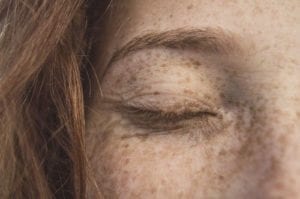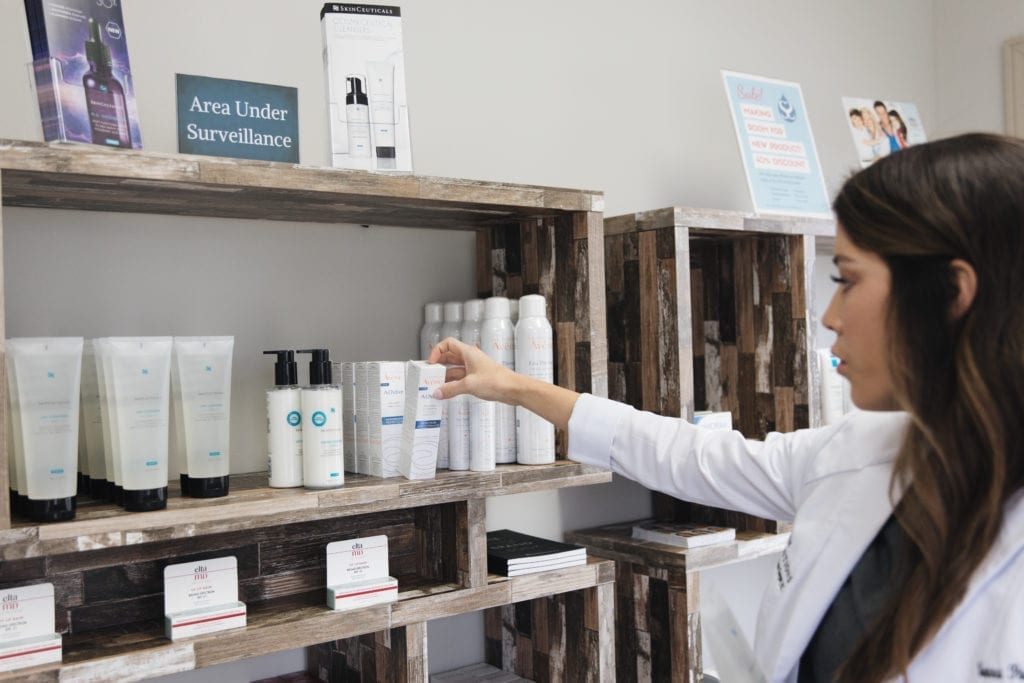
Do you ever look at a baby’s skin and it occurs to you their skin is flawless? Not a single freckle or pigmentation change. As we age and the day to day sun exposure accumulates, we begin to collect areas of pigmentation change. Keep reading for how to get rid of dark spots.
In today’s post I will explain the most common types of pigmentation change I see in office and get asked about in everyday conversation along with how to reverse- YES we can get your skin back to that clean canvas of a baby!
Freckles
The most common pigment change I see is just plain ‘ole freckles. These are from years and years of sun exposure.
Even if you never worshiped the sun and diligently applied your sunscreen, UV rays can still get through chemically based sunscreens.
You should be applying a DAILY zinc based sunscreen. You brush your teeth everyday (I hope) so you can just get used to applying a zinc based moisturizer right after.
Zinc is a metal and the only physical block from all UV rays. So, even if you start investing in the options I will discuss below, if you do not start implementing a zinc based sunscreen into your day to day routine you are wasting your money.
You cannot avoid the sun and the pigment will immediately return from the sun exposure unless you have a block from it.
My Favorite daily moisturizer with SPF for normal to dry skin: Elta UV Elements
My favorite daily moisturizer with SPF for normal to oily skin: Elta UV Clear
To read more about skincare products and how to build the right skincare regimen for you CLICK HERE.
Melasma
Second most common pigment change I see in practice is melasma. Melasma has a genetic component in which the melanocytes (cells that give your skin pigment) are overproduced and cause dark patches on the skin.
Most common areas where melasma is observed is the forehead, cheeks, around the eyes, and upper lip (less commonly found on the arms and neck).
Triggers include the sun, hormones, pregnancy, hypothyroid and certain medications (oral and topical).
You can decipher melasma from freckles because melasma is usually a large patch with irregular borders whereas freckles are scattered brown/tan individual lesions (almost looks as if paint was splattered in the area).
Post Inflammatory Hyperpigmentation
Lastly, I see a lot of post inflammatory hyperpigmentation (PIH) in clinic from acne but also from any type of insult to the skin.
So what exactly is it? Any time there is trauma/inflammation to the skin (acne, rash, or just a cut), the area will heal and leave a red/purple pigment where the initial insult was for a few months. This is temporary and most likely will fade with time.
Topical Therapy
The least invasive treatments for the above are topical medications and appropriate skincare products.
A daily vitamin C in the morning will prevent and reverse oxidative damage from the sun (recommended products linked below) and your skin will appear brighter and more even-toned. As discussed previously, following vitamin C should be a moisturizer with at least 6% zinc to prevent pigmentation from returning or getting worse.
All vitamin C are not created equally. I recommend you select one with at least 10% vitamin C. The most effective form of vitamin C will be listed in ingredients as ascorbic acid. Although ascorbic acid is the most beneficial for your skin, it is very PH dependent and must be paired with the correct ingredients. Otherwise it could oxidize too quickly and inactivate.
CLICK HERE to read more about vitamin C and what to look for in ingredients.
The most concentrated form of vitamin C will be in serums.
In my opinion, The HOLY GRAIL (Although it is $$$): Skinceuticals CE Ferulic
More affordable alternative although contains less antioxidants (think of this as pure vitamin C with no added benefits): Skinceuticals Serum 10
A great drugstore option: La Roche-Posay Redermic Pure Vitamin C10 Serum
La Roche-Posay Redermic C is not a serum but super affordable Vitamin C Lotion!
There are topical prescriptions through a doctor’s office that can be prescribed to lighten the areas of darker pigment. These prescriptions aim to stop the formation of melanin (pigmentation): hydroquinone, azelaic acid, and kojic acid to name a few. Consult with your healthcare provider if you feel like you would benefit from one of these.
A comprehensive skincare routine will help keep dark spots at bay once reversed or lightened as well.

Laser Therapy
The most invasive and quickest results is laser therapy. I don’t want to go into a huge amount of detail with which types of lasers because there are multiple. It would be most beneficial for the provider you consult with to choose the laser best suited for your skin concerns.
The laser I prefer and have used on my skin in the past is a pulsed light laser. In summary, this laser will grab onto any pigment, bring it to the surface, and it will slough off.
Sounds too good to be true, right!? This is why I love these lasers!
Minimal to no downtime and awesome results. The kicker is, you will more than likely need at least 2-3 treatments for complete correction of pigment. Lasers will also help to decrease fine lines, pore size, and any redness of the face depending on which is recommended to you.
In summary, when anyone comes to me with pigmentation concerns I will discuss their options as explained above.
Ultimately I recommend trying topical therapy for 3 months and even if the pigmentation is not fully reversed, we usually see a lot of improvement.
If the minimal pigmentation left is still of concern, then I recommend laser treatment.
Personally, I use topical therapy for 3 months twice a year just to keep the pigmentation at bay (I suffer from melasma and get a really nice pigmented mustache on my upper lip:)).
Always ensure you consult a dermatology provider prior to treatment to ensure the pigmentation you wish to treat is benign and there is no malignant concern!

Hey Vanna,
I went to nursing school with Christy Padilla, which is how I came across your Instagram account through her and then found your awesome blog! I am a Family NP so we do take care of some simple derm cases, but refer a good bit when “it’s over our head.” This blog has been so informative and helpful, even in my personal skin care. I have melasma that has been driving me crazy since my last baby was born 2 years ago. Which vitamin C topical is your favorite that you linked above and which zinc sunscreen do you prefer?
Thanks again for all your doing!
Kate,
Thanks so much for writing! The Redermic C is a great affordable option and is what I used when I just started a skincare routine. When I was confident vitamin C was working for me and convinced I could feel comfortable splurging on it, CE Ferulic is hands down my go-to. If you’re willing to splurge you will not regret this purchase! But I linked 3 vitamin C products all at different price points! I’ve used them all and I stand behind their effectiveness for their price. As far as the sunscreen goes, it depends on your skin type- are you oily or dry? Elta is my all time favorite (the UV clear to be exact) but I do get it’s a little more pricey. Although, you’re getting way more than just a sunscreen, Elta products are so moisturizing and depending which one you pick will help with other issues! Dry- elta UV facial. And Oily- elta UV clear if your budget allows 🙂
Thanks again for reading Kate! Don’t hesitate to reach out if you need anything moving forward!
Thanks so much! That is all very helpful!